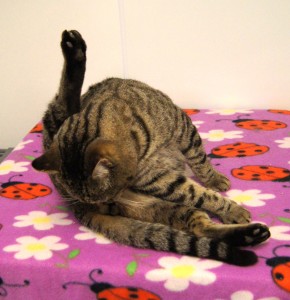 Research at Ohio State University last year proved that it doesn’t take much to get a cat off his or her regular routine. In fact, all it took was a change in caretakers for many of their cats to become ill.
Research at Ohio State University last year proved that it doesn’t take much to get a cat off his or her regular routine. In fact, all it took was a change in caretakers for many of their cats to become ill.
As Tony Buffington, the lead researcher, says, “Cats are not a pack species. They are not used to living in large groups. Their two primary predators are larger carnivores and primates and so who do they live with? Dogs and people. It can be tough being a cat.”
Cats who come into shelters also face a barrage of stressful changes besides being forced to make nice with other cats: they’ve lost their people, their familiar space, most of the objects that make up their world and often, the food they’re used to.
We try to make their transitions as easy as possible, but often their bodies respond with loose stools or diarrhea. It’s a common problem in cats at home too.
These are a couple of natural remedies that we have used with success, both at Happy Cats and with our own cats.
Slippery Elm Syrup
Slippery elm is a bark that contains mucilage and tannins that coat the digestive tract. Its use for pets (and people!) is well documented. It’s great for small upsets, like helping a cat pass a hairball (many cats will have diarrhea around the time the hairball is coming up). If your cat is just starting to have intestinal upsets, try this.
Bring 1 cup water to a hard boil. Remove from heat and whisk in 2 teaspoons slippery elm powder (find it at your local health food store…bulk is easiest to work with). It should thicken up, like syrup. Run it through a blender if it lumps up too much.
You can add this to a cat’s wet food up to 3 times a day, using up to a teaspoon each time. Most cats will tolerate it in their food. Start with 1/4 teaspoon at first, building up to 1 teaspoon. Please remember that adding different flavors of canned food suddenly can also precipitate diarrhea, so stick with what the cat knows.
Gut Goop Light
We’ve recently simplified our recipe based on information from Dr. Becker in this article. It’s much simpler and easy to make and has proven to work just as well as the original Gut Goop recipe. It’s also better for cats who may have a grain sensitivity.
1 jar Beechnut turkey baby food (make sure it’s Beechnut as Gerber’s has cornstarch)
1 baby food jar plain cooked pumpkin (freeze the rest for later)
1 baby food jar Slippery Elm Syrup (above)
Combine and decant into the 3 jars, freezing two. It should keep thawed in the fridge for about a week.
To dose: Give 1 teaspoon for an adult up to twice a day. Add 1/2 capsule of any good human probiotic. Start kittens or small cats with 1/4 teaspoon and 1/4 capsule probiotics, building up to 1/2 teaspoon twice a day.
Gut Goop
Intestinal illnesses are notoriously difficult to diagnose because the parasites can be alive in different stages in the colon. We often use this mixture to build intestinal health in cats and kittens who have severe or chronic diarrhea, especially after they’ve been treated medically. This mixture soothes and rebuilds the gut, where some say up to 90% of the immune function resides.
The best way to use this to help with diarrhea is to combine it with an elimination diet. Remove from the cat’s diet all but the main food you know your cat tolerates well (no treats please!). Add this in once a day. This isn’t an overnight fix, but can slowly rebuild the intestinal tract back to health. If your cat has diarrhea, look for a gradual shift to some formed stools within 3-5 days and more formed stools within a week. Some cats take longer, but please see your veterinarian if the diarrhea persists.
WARNING: If using this for kittens, monitor very carefully. Each kitten is different, so some may need less than others…or none. Too much can throw a well kitten into constipation, which can be deadly, so make sure the kitten has diarrhea before using this.
1 can plain pumpkin puree
2 cups slippery elm syrup
1 cup Ener-G rice bran, powdered in blender or grinder
1/8 t. taurine, powdered
Five 100mg capsules PABA, powdered in mortar/pestle if necessary
Bifidyn Bifidus
Put rice bran in blender or grinder and blend till finely powdered. Add pumpkin and SE syrup and blend well. Add taurine and finely powdered PABA until mixed. Add to a teaspoon or so plain cooked, chopped chicken or canned food. Portion out and add a pinch of Bifidyn Bifidus powder (not the capsules…you want to avoid anything with magnesium stearate in it) per cat at serving time.
Use up to 1 teaspoon per adult cat per day, 1/4 – 1/2 teaspoon for kittens. Most cats aren’t familiar with the taste of pumpkin, so start slowly, adding 1/8 teaspoon at a time. If your cat can tolerate it, you can add up to 2 cups bran in this recipe. It makes a lot but freezes well in smaller containers.
We’ve had success with many cats and kittens on this formula and most seem to tolerate it; many even like it! Once your cat stops having diarrhea, you can save the recipe for only when it’s needed.
Of course, if the diarrhea persists, please see your veterinarian for further assistance. These are first aid recommendations only!
Thanks to Dr. Jean Hofve and her book, The Complete Guide to Holistic Cat Care: An Illustrated Handbook for her invaluable information on feline intestinal health.





